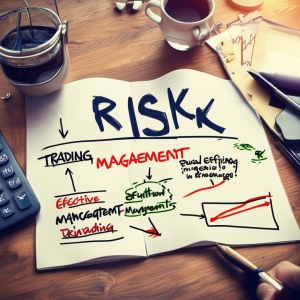Table of Contents:
Risk Management
As a beginner trader, you're likely eager to dive into the markets and start making some profits. However, before you do, it's crucial that you understand the importance of risk management. Without proper risk management, even the most skilled traders can find themselves in trouble.
In this article, we'll cover the basics of risk management for traders, including why it's important, how to implement it, and some best practices to keep in mind.
Why Is Risk Management Important in Trading?
Risk management is crucial in trading because it helps you protect your capital and prevent significant losses. In trading, losses are inevitable, and no trader can avoid them entirely. However, a sound risk management plan can help you keep losses small and manageable, while allowing you to ride out winning trades to maximize profits.
Without a risk management plan, you run the risk of blowing your entire account on a few bad trades. By limiting your exposure to any one trade or position, you can protect your capital and stay in the game long enough to see success.
How to Implement Risk Management in Your Trading Strategy
Now that you understand the importance of risk management, let's dive into how to implement it into your trading strategy.
1. Define Your Risk Tolerance
The first step in implementing risk management is to define your risk tolerance. This refers to the amount of money you're willing to risk on any one trade or position. Your risk tolerance will depend on a variety of factors, including your trading experience, your financial situation, and your personal preferences.
Once you've defined your risk tolerance, you can use it to determine your position size and set stop-loss orders to limit your potential losses.
2. Use Stop-Loss Orders
Stop-loss orders are an essential tool in risk management. A stop-loss order is an order that automatically closes out a trade if it reaches a certain price level. By using stop-loss orders, you can limit your potential losses on any one trade.
It's essential to set your stop-loss orders at a level that makes sense for your trading strategy and risk tolerance. If your stop-loss order is too close to your entry point, you may get stopped out too quickly, and if it's too far away, you may be risking too much on any one trade.
3. Diversify Your Portfolio
Diversification is another key element of risk management. By spreading your capital across multiple positions and asset classes, you can reduce your overall risk exposure. If one position or asset class performs poorly, your losses will be limited because you have other positions that can potentially make up for the losses.
It's essential to diversify across different asset classes and not just different stocks or currencies. Diversification can include stocks, bonds, commodities, and cryptocurrencies, among others.
Best Practices for Risk Management in Trading

Now that you understand how to implement risk management in your trading strategy, let's cover some best practices to keep in mind.
1. Keep a Trading Journal
Keeping a trading journal is an excellent way to track your progress and identify areas for improvement. In your trading journal, you can record your trades, including the entry and exit points, position size, and the reason for the trade. By reviewing your journal regularly, you can identify patterns in your trading and adjust your strategy accordingly.
2. Avoid Emotional Trading
Emotional trading is one of the biggest risks in trading. When you let your emotions drive your trading decisions, you're more likely to make mistakes and take on more risk than you should. To avoid emotional trading, it's important to stick to your trading plan and avoid impulsive decisions.
3. Stay Educated
Finally, staying educated is essential for successful trading and risk management. The markets are constantly changing, and new opportunities and risks are always emerging. By staying informed and up-to-date on the latest market news and trends, you can make more informed decisions and adjust your trading strategy accordingly.
You can stay educated by reading trading blogs and news sites, attending webinars and seminars, and participating in trading communities. By learning from experienced traders and staying informed on the markets, you can improve your trading skills and reduce your overall risk.
Conclusion
In conclusion, risk management is an essential component of any trading strategy, especially for beginners. By defining your risk tolerance, using stop-loss orders, diversifying your portfolio, and following best practices, you can protect your capital and increase your chances of success in the markets.
Remember, trading is a marathon, not a sprint, and it takes time and effort to become a successful trader. By incorporating risk management into your trading strategy and staying informed and educated, you can improve your skills and achieve your trading goals.
FAQs about Protect Your Capital with Effective Risk Management in Trading

What is risk management in trading?
Risk management in trading is the process of identifying potential risks, measuring them, and implementing strategies to mitigate losses. This can involve setting stop-loss orders, diversifying investment portfolio, and limiting trade sizes among others.
Why is risk management important in trading?
Risk management is crucial in trading to protect your capital from substantial losses. Effective risk management strategies ensure that losses from individual trades do not significantly impact the overall trading portfolio.
What are some effective risk management strategies in trading?
Some effective risk management strategies in trading include diversification, hedging, position sizing, and use of stop orders. Also, understanding and analyzing market trends can help manage risks better.
How can I protect my capital in trading?
You can protect your capital in trading by implementing a well-considered risk management plan. This involves setting appropriate risk-reward ratios, using stop-loss orders, diversifying your investments, and trading only what you can afford to lose.
How does diversification help in risk management?
Diversification, or spreading your investments across different types of assets or markets, helps in risk management by reducing the effect of poor performance of a single asset or market on the overall trading portfolio. This helps protect capital as losses from one investment can be offset by gains in another.












